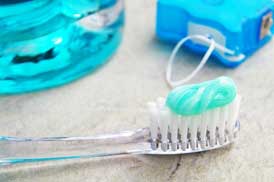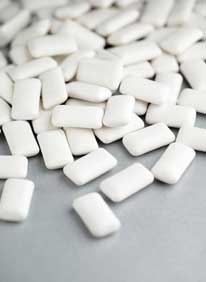 Ever look on the back of the toothpaste box and wonder, what exactly is xanthan gum and why the heck is it in my toothpaste? Well wonder no more, as we go through how to decode the toothpaste label…
On every drug facts label you find a listing of active ingredients and inactive ingredients, as well as what its used for, any warnings for the product and directions for uses.
Active Ingredients: This is the part of the toothpaste that makes its use effective. In the case of most toothpastes the active ingredient is usually for anti-plaque, anti-cavity, anti-gingivitis as well as including ingredients to help prevent tooth sensitivity. So in this portion you will normally see your fluorides such as sodium fluoride, stannous fluoride or sodium monofluorophosphate. You may also see potassium nitrate, triclosan, pyrophosphates or zinc salts as well as a myriad of other ingredients.
Inactive Ingredients: This portion includes the ingredients that make the toothpaste standup to being on the shelf as well as completing the nuts and bolts function of general toothpaste use. So these ingredients stop the paste from drying out, keep it at a good pH, stop microbial growth, make them thick enough for use and help them become foamy when used. They also include flavoring agents, abrasives and whitening agents. So in this section, which in my opinion is the most confusing you’ll see these types of ingredients:
Ever look on the back of the toothpaste box and wonder, what exactly is xanthan gum and why the heck is it in my toothpaste? Well wonder no more, as we go through how to decode the toothpaste label…
On every drug facts label you find a listing of active ingredients and inactive ingredients, as well as what its used for, any warnings for the product and directions for uses.
Active Ingredients: This is the part of the toothpaste that makes its use effective. In the case of most toothpastes the active ingredient is usually for anti-plaque, anti-cavity, anti-gingivitis as well as including ingredients to help prevent tooth sensitivity. So in this portion you will normally see your fluorides such as sodium fluoride, stannous fluoride or sodium monofluorophosphate. You may also see potassium nitrate, triclosan, pyrophosphates or zinc salts as well as a myriad of other ingredients.
Inactive Ingredients: This portion includes the ingredients that make the toothpaste standup to being on the shelf as well as completing the nuts and bolts function of general toothpaste use. So these ingredients stop the paste from drying out, keep it at a good pH, stop microbial growth, make them thick enough for use and help them become foamy when used. They also include flavoring agents, abrasives and whitening agents. So in this section, which in my opinion is the most confusing you’ll see these types of ingredients:
- Propylene glycol, glycerol, and polyethylene glycol to help keep toothpaste moist
- Carageenan, cellulose and xanthan gum to thicken and hold all the ingredients together
- Sodium benzoate and methyl paraben to keep toothpaste from decaying and to prevent microbial growth
- Sodium lauryl sulphate and cocoadmidopropyl betaine to make toothpaste foam thereby helping loosening and removing plaque from the tooth surface.
- sodium saccharin, xylitol, sorbitol, sodium cyclamate to flavor the toothpaste.
- Buffering agents to make it a pH favorable for the oral environment.
- And, you may see silicas, dicalcium phosphate dihydrate or aluminum oxide which are abrasives which help remove plaque and bacteria as well.

 After years in the dental office, I can tell you that it’s very rare to find a patient who goes more than 3 years without a cavity.
Knowing that home care is one of the most important aspects of maintaining a healthy mouth, my partners and I set out on creating a home care regimen that’s relatively easy and will provide the results we are hoping to achieve, a decrease in cavities and improvement in overall oral health.
The final breakthrough of my home care routine recommendations came while reading Dr. Ellie Phillips book Kiss Your Dentist Goodbye. During our daily care routine, we are mainly focusing on removing and repairing the damage we’ve already done during the day. Removing plaque mostly and strengthening enamel. However, Dr. Ellie’s book brings up a great point, we aren’t focusing on improving the overall environment of the mouth, more specifically saliva makeup.
Combining both rationales, ours which focuses on mechanics and repair, and Dr. Ellie’s which focuses on reducing the saliva’s acidity and creating a healthier environment in the mouth, we created Frangella Dental’s basic home care regimen:
After years in the dental office, I can tell you that it’s very rare to find a patient who goes more than 3 years without a cavity.
Knowing that home care is one of the most important aspects of maintaining a healthy mouth, my partners and I set out on creating a home care regimen that’s relatively easy and will provide the results we are hoping to achieve, a decrease in cavities and improvement in overall oral health.
The final breakthrough of my home care routine recommendations came while reading Dr. Ellie Phillips book Kiss Your Dentist Goodbye. During our daily care routine, we are mainly focusing on removing and repairing the damage we’ve already done during the day. Removing plaque mostly and strengthening enamel. However, Dr. Ellie’s book brings up a great point, we aren’t focusing on improving the overall environment of the mouth, more specifically saliva makeup.
Combining both rationales, ours which focuses on mechanics and repair, and Dr. Ellie’s which focuses on reducing the saliva’s acidity and creating a healthier environment in the mouth, we created Frangella Dental’s basic home care regimen:
 Being in the dental field, I’ve noticed that about a month before the wedding, patients begin to panic and realize that the smile they’ve loved all their lives just isn’t wedding picture perfect. Unfortunately, the smile of most people’s dreams cannot be acheived in less than 3-4 weeks. If you’re recently engaged and not exactly sure where to start, here is Frangella Dental’s Wedding Countdown Guide:
Being in the dental field, I’ve noticed that about a month before the wedding, patients begin to panic and realize that the smile they’ve loved all their lives just isn’t wedding picture perfect. Unfortunately, the smile of most people’s dreams cannot be acheived in less than 3-4 weeks. If you’re recently engaged and not exactly sure where to start, here is Frangella Dental’s Wedding Countdown Guide:
 Conscious sedation is a procedure that allows you to get the dental care you need while remaining stress free and comfortable.
Conscious sedation is defined as a minimally depressed state of consciousness that allows the retention of the ability to respond and react to physical stimulation and verbal command. During the sedated state most patients experience an amnesic effect that can erase any memory of the procedure.
It is a great tool that can help you achieve the smile you’ve always wanted but were kept from getting due to your fear of the dentist. If you are afraid to go to the dentist, or just anxious about certain aspects of your dental treatment, sedation may be a solution to your anxiety.
Unlike general anesthesia where the patient is unconscious or asleep, conscious sedation allows you to be awake but in a very relaxed state. Our certified IV conscious sedation dentist, Dr. Tina Frangella, can give you the ability to have your dental treatment completed while you are in a sedated and relaxed state.
Sedation Dentistry can give you the peace of mind you need in order to undergo dental work with no memory of the treatment that was done. It will allow you to receive the care necessary for you to enjoy better overall health, an improved self-image, and better quality of life with a healthy, beautiful smile.]]>
Conscious sedation is a procedure that allows you to get the dental care you need while remaining stress free and comfortable.
Conscious sedation is defined as a minimally depressed state of consciousness that allows the retention of the ability to respond and react to physical stimulation and verbal command. During the sedated state most patients experience an amnesic effect that can erase any memory of the procedure.
It is a great tool that can help you achieve the smile you’ve always wanted but were kept from getting due to your fear of the dentist. If you are afraid to go to the dentist, or just anxious about certain aspects of your dental treatment, sedation may be a solution to your anxiety.
Unlike general anesthesia where the patient is unconscious or asleep, conscious sedation allows you to be awake but in a very relaxed state. Our certified IV conscious sedation dentist, Dr. Tina Frangella, can give you the ability to have your dental treatment completed while you are in a sedated and relaxed state.
Sedation Dentistry can give you the peace of mind you need in order to undergo dental work with no memory of the treatment that was done. It will allow you to receive the care necessary for you to enjoy better overall health, an improved self-image, and better quality of life with a healthy, beautiful smile.]]>  Being a dentist and being surrounded by a lot of dentists, I’ve had the opportunity to try a lot of dental products over the years and learn the opinions of my friends, family and colleagues about these same products.
I decided to compile a list of my absolute favorite, tried and true, dental products on the market. Of course I’m always open to try something new, so if you have any favorites, please let us know!
Being a dentist and being surrounded by a lot of dentists, I’ve had the opportunity to try a lot of dental products over the years and learn the opinions of my friends, family and colleagues about these same products.
I decided to compile a list of my absolute favorite, tried and true, dental products on the market. Of course I’m always open to try something new, so if you have any favorites, please let us know!

 100% Xylitol can be consumed in many different product forms: mints, gum, lollipops, and granular just to name a few. Many commercial sugarless gums, which are not 100% Xylitol, contain approximately .5 grams of Xylitol per piece. It is recommended that 6-10 grams of Xylitol be consumed daily by children and adults. Therefore, it is recommended that a product with 100% Xylitol be consumed instead.
Products with 100% Xylitol can be difficult to find at your everyday local grocery store but you can usually find 100% Xylitol at health/organic food stores and on the Internet.
Xylitol is also recommended for infants and can be started with a few grams a day once the teeth begin erupting, working up to 6-10 grams as all the teeth have fully erupted. Since babies cannot chew gum/lollipop/mints, we recommend Xylitol be introduced in a granular form mixed in water. A wash cloth bathed in this solution can be used to clean the newly erupted teeth. Speak with your dentist or a pediatric dentist before introducing Xylitol.]]>
100% Xylitol can be consumed in many different product forms: mints, gum, lollipops, and granular just to name a few. Many commercial sugarless gums, which are not 100% Xylitol, contain approximately .5 grams of Xylitol per piece. It is recommended that 6-10 grams of Xylitol be consumed daily by children and adults. Therefore, it is recommended that a product with 100% Xylitol be consumed instead.
Products with 100% Xylitol can be difficult to find at your everyday local grocery store but you can usually find 100% Xylitol at health/organic food stores and on the Internet.
Xylitol is also recommended for infants and can be started with a few grams a day once the teeth begin erupting, working up to 6-10 grams as all the teeth have fully erupted. Since babies cannot chew gum/lollipop/mints, we recommend Xylitol be introduced in a granular form mixed in water. A wash cloth bathed in this solution can be used to clean the newly erupted teeth. Speak with your dentist or a pediatric dentist before introducing Xylitol.]]>